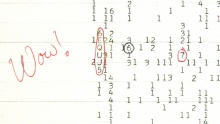“Wow! 信号”的版本间差异
(新页面: <big>'''Wow! 信号'''</big> 220px|right|thumb|Wow! 信号 The Wow! signal was a strong, narrowband radio signal detected by Dr. Jerry R. Ehman on August 15, 19...) |
Zhouxiaobo(讨论 | 贡献) (稍微更新一段。) |
||
| (未显示2个用户的7个中间版本) | |||
| 第1行: | 第1行: | ||
| + | {{Editing|zhouxiaobo|最近很累,又有许多事,需要在一个月后继续更新。}} | ||
| + | |||
| + | |||
| + | |||
<big>'''Wow! 信号'''</big> | <big>'''Wow! 信号'''</big> | ||
| + | [[Image:Wow_signal.jpg|220px|right|thumb|Wow! 信号]] | ||
| − | |||
| − | + | Wow! 信号是由工作在俄亥俄州立大学大耳无线电望远镜项目(SETI) Jerry R. Ehman 博士于1977年8月15日检测到的一个强大的窄带无线电信号,这个信号印证了潜在的非陆地和非太阳系的起源。它持续了72秒,整个期间由大耳无线电望远镜观察,但是它并没有再次被检测到。当谈论到 SETI 项目的成果时,它一直是主流媒体关注的焦点。 | |
| + | 惊讶于它如此贴切用天线所期望得到的外星智能信号,Ehman 博士将在电脑上打印输出的信号圈出并在一旁写下注释“哇!”这个注释成为了信号的名称。 | ||
| − | |||
| − | ==''' | + | =='''技术细节'''== |
| − | + | 被圈出来的字母代码 6EQUJ5 描述了信号的强度变化。每一个空隔表示介于 0到0.999之间。数字 1到9 表示对应带编号的强度(从1.000到9.999),高于 10.0的强度用字母表示(A的强度相当于10.0到10.999,B的强度相当于11.0到11.999,以此类推)。字母U所表示的值为30.0到30.999之间,是这台望远镜所曾检测到的最大值。在这种情况下的强度是无单位的信噪噪声比,是在数分钟之前这个频带上的平均值。 | |
| − | + | 信号的位宽小于10kHz(在打印出的每一页对应着 10 kHz位宽的信道,信号是唯一的在一列之中)。 | |
| + | 已经给出了两个不同的频率值:1420.356MHz(J. D. Kraus)和1420.456MHz(J. R. Ehman) | ||
| + | ,二者与氢线 1420.406 MHz 的差异小于 50 kHz 。两个可能的赤道坐标已给出: | ||
| 第21行: | 第27行: | ||
| − | + | 两个坐标都在 = -27°03´ ± 20´ (epoch B1950.0). | |
| − | + | 大耳望远镜固定着随着地球的旋转扫描星空,依据地球自传的速率以及观测窗口的宽度。它可以在72秒内观察任何给出的点。因此,一个地球之外的信号将只能记录72秒钟,并且记录的强度在第36秒时会达到顶峰,直到信号到达了大耳望远镜观测窗口的中心,这时它会呈现逐步下降趋势。 | |
| − | |||
Therefore, both the length of the Wow! signal, 72 seconds, and its shape would correspond to a possible extraterrestrial origin. | Therefore, both the length of the Wow! signal, 72 seconds, and its shape would correspond to a possible extraterrestrial origin. | ||
| − | |||
=='''Searches for recurrence of the signal'''== | =='''Searches for recurrence of the signal'''== | ||
| 第71行: | 第75行: | ||
*[[SETI]] | *[[SETI]] | ||
| − | [[Category:SETI]] | + | [[Category:SETI]][[Category:待翻译]] |
2013年5月14日 (二) 20:10的最新版本
| 该页面正在被编辑 用户 zhouxiaobo 正在编辑该页面,尚未完工。请其他Wiki用户不要同时编辑,以避免冲突。
该用户的说明:最近很累,又有许多事,需要在一个月后继续更新。 。 如果该页面长期无人编辑,请去除该模板并添加上合适的页面状态模板。 欢迎无wiki账号的用户到论坛的Wiki系统讨论区(注册)参与讨论,有账号用户请到讨论:Wow! 信号发表见解。 |
Wow! 信号
Wow! 信号是由工作在俄亥俄州立大学大耳无线电望远镜项目(SETI) Jerry R. Ehman 博士于1977年8月15日检测到的一个强大的窄带无线电信号,这个信号印证了潜在的非陆地和非太阳系的起源。它持续了72秒,整个期间由大耳无线电望远镜观察,但是它并没有再次被检测到。当谈论到 SETI 项目的成果时,它一直是主流媒体关注的焦点。
惊讶于它如此贴切用天线所期望得到的外星智能信号,Ehman 博士将在电脑上打印输出的信号圈出并在一旁写下注释“哇!”这个注释成为了信号的名称。
技术细节
被圈出来的字母代码 6EQUJ5 描述了信号的强度变化。每一个空隔表示介于 0到0.999之间。数字 1到9 表示对应带编号的强度(从1.000到9.999),高于 10.0的强度用字母表示(A的强度相当于10.0到10.999,B的强度相当于11.0到11.999,以此类推)。字母U所表示的值为30.0到30.999之间,是这台望远镜所曾检测到的最大值。在这种情况下的强度是无单位的信噪噪声比,是在数分钟之前这个频带上的平均值。
信号的位宽小于10kHz(在打印出的每一页对应着 10 kHz位宽的信道,信号是唯一的在一列之中)。
已经给出了两个不同的频率值:1420.356MHz(J. D. Kraus)和1420.456MHz(J. R. Ehman)
,二者与氢线 1420.406 MHz 的差异小于 50 kHz 。两个可能的赤道坐标已给出:
- R.A. = 19h22m22s ± 5s
- R.A. = 19h25m12s ± 5s
两个坐标都在 = -27°03´ ± 20´ (epoch B1950.0).
大耳望远镜固定着随着地球的旋转扫描星空,依据地球自传的速率以及观测窗口的宽度。它可以在72秒内观察任何给出的点。因此,一个地球之外的信号将只能记录72秒钟,并且记录的强度在第36秒时会达到顶峰,直到信号到达了大耳望远镜观测窗口的中心,这时它会呈现逐步下降趋势。
Therefore, both the length of the Wow! signal, 72 seconds, and its shape would correspond to a possible extraterrestrial origin.
Searches for recurrence of the signal
The Big Ear telescope used two feed horns to search for signals, each pointing to a slightly different direction in the sky following Earth's rotation; the Wow! signal was detected in one of the horns but not in the other, although the data were processed in such a way that it is impossible to determine in which of the two horns the signal entered. In any case, the signal was expected to appear a mere three minutes apart in each of the horns, but this did not happen. Ehman unsuccessfully looked for recurrences of the signal using Big Ear in the month after the detection.
In 1987 and 1989, Robert Gray searched for the event using the META array at Oak Ridge Observatory, but did not re-detect it.
In 1995 and 1996, Gray also searched for the signal using the Very Large Array, which is significantly more powerful than Big Ear.
Gray and Dr. Simon Ellingsen later searched for recurrences of the event in 1999 using the University of Tasmania's Hobart 26m radio telescope.[5] Six 14-hour observations were made at positions in the vicinity, but did not detect anything similar to the Wow signal.
Speculations on the origin
Interstellar scintillation of a weaker continuous signal — similar, in effect, to atmospheric twinkling—could be a possible explanation, although this still would not exclude the possibility of the signal being artificial in its nature. However, even by using the significantly more sensitive Very Large Array, such a signal could not be detected, and the probability that a signal below the Very Large Array level could be detected by the Big Ear radio telescope due to interstellar scintillation is low.[4] Other speculations include a rotating lighthouse-like source, a signal sweeping in frequency, or a one time burst. Some have also suggested it could have come from a moving space vehicle of extraterrestrial origin.
Ehman has stated his doubts that the signal is of intelligent extraterrestrial origin: "We should have seen it again when we looked for it 50 times. Something suggests it was an Earth-sourced signal that simply got reflected off a piece of space debris."
He later recanted his skepticism somewhat after further research scientifically relegated an Earth-bound signal to be astronomically unlikely, due to the requirements of a space-borne reflector being bound to certain unrealistic requirements to sufficiently explain the nature of the signal. Also, the 1420 MHz signal is problematic in itself in that it is "protected spectrum" or bandwidth in which terrestrial transmitters are forbidden to transmit. In his most recent writings, Ehman resists "drawing vast conclusions from half-vast data."
Location of the signal
- The location of the signal in celestial coordinates was, at (epoch J2000.0)
- Right Ascension (On the positive horn): 19h25m31s ± 10s
- Right Ascension (On the negative horn): 19h28m22s ± 10s
- Declination (Is the same for both horns): -26d57m ± 20m
- This region of the sky lies in the constellation Sagittarius, roughly 2.5 degrees south of the fifth-magnitude star Chi-1 Sagittarii.
